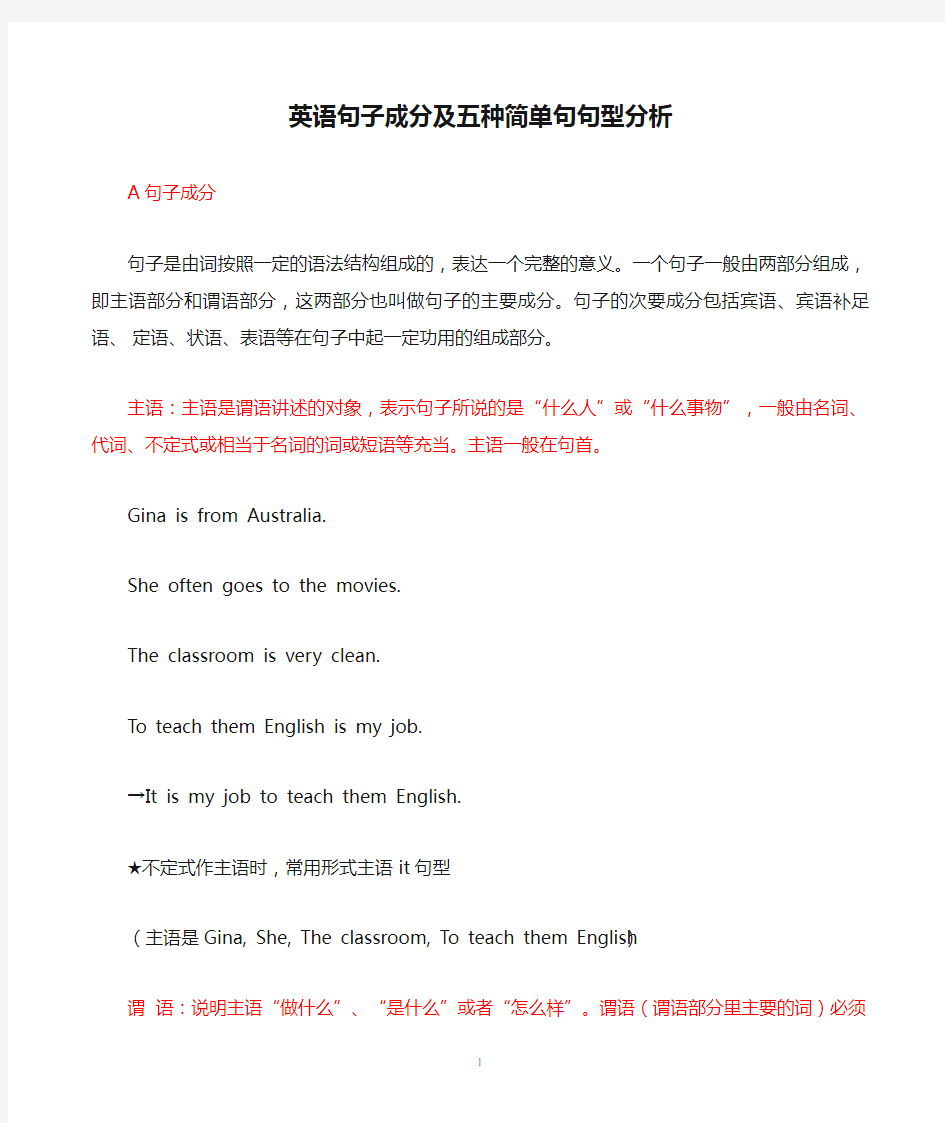英语句子成分及五种简单句句型分析

- 1、下载文档前请自行甄别文档内容的完整性,平台不提供额外的编辑、内容补充、找答案等附加服务。
- 2、"仅部分预览"的文档,不可在线预览部分如存在完整性等问题,可反馈申请退款(可完整预览的文档不适用该条件!)。
- 3、如文档侵犯您的权益,请联系客服反馈,我们会尽快为您处理(人工客服工作时间:9:00-18:30)。
英语句子成分及五种简单句句型分析
A句子成分
句子是由词按照一定的语法结构组成的,表达一个完整的意义。一个句子一般由两部分组成,即主语部分和谓语部分,这两部分也叫做句子的主要成分。句子的次要成分包括宾语、宾语补足语、定语、状语、表语等在句子中起一定功用的组成部分。
主语:主语是谓语讲述的对象,表示句子所说的是“什么人”或“什么事物”,一般由名词、代词、不定式或相当于名词的词或短语等充当。主语一般在句首。
Gina is from Australia.
She often goes to the movies.
The classroom is very clean.
To teach them English is my job.
→It is my job to teach them English.
★不定式作主语时,常用形式主语it句型
(主语是Gina, She, The classroom, To teach them English )
谓语:说明主语“做什么”、“是什么”或者“怎么样”。谓语(谓语部分里主要的词)必须用动词。谓语和主语在“人称”和“数”两方面必须一致。谓语一般在主语后面。
We are both quiet.
He has a toothache.
She looks well.
We study hard.
We have finished the job.
He can speak English.
(谓语是are quiet; has a toothache; looks well; study; have finished; can speak)
表语:说明主语“是什么”或者“怎么样”,由名词、形容词或相当于名词或形容词的词或短语等充当,和系动词一起构成谓语。一般在系动词后面。
Her mother is a bank clerk.
Are you ready?
Our country is getting stronger.
You look younger than before.
My book is on the desk.
Everybody is here.
(表语:a bank clerk; ready; getting stronger; younger; on the desk; here)
宾语:表示动作、行为的对象,由名词、代词或相当于名词的词或短语等充当,和及物动词一起说明主语“做什么”。一般在谓语之后。或放在介词后,做介词的宾语。
All of us like him.
He’s playing soccer.
Can I ask some questions?
She is playing the piano now.
He often helps me.
Lucy likes to sleep in the open air.
We enjoy living in China.
(宾语是him; soccer; questions; the piano; me; to sleep; living)
有些动词后面需要跟有双宾语,间接宾语指人,直接宾语指物。这类动词常见的有:give, buy, lend,pass ,show, tell, sent, leave等。如:
He bought me a book.
Pass me the ball,will you?
定语:用来修饰名词或代词。由形容词、代词、数词、名词、介词短语不定式或相当于形容词的词或短语等充当。
因为名词、代词既可做主语,又可做表语、宾语,所以定语的位置很灵活,凡有名词、代词的地方都可以有定语。
I have something to do.
What’s your name, please ?
She’s a good basketball player.
The girl behind the tree is my sister.
The little boy gave me a big apple.
The black bike is mine.
They made paper flower.
(to do; your; good; behind the tree; little, big; black; paper)
状语:用来修饰动词、形容词或副词,一般表示行为发生的时间、地点、原因、目的、结果、条件、方向、程度、方式和伴随状况等意义,通常由副词、介词短语不定式或相当于副词的词或短语,或由连词引导状语从句等来充当。
(1) 时间状语
I often get up at 5:30 in the morning. 我常常在早上5:30起床。
Hearing the news, they felt very excited. 听到这个消息,他们感到很兴奋。
Go along this street until you reach the end. 沿着这条街走直到到达尽头为止。
(2) 地点状语
Pandas only live in China. 熊猫仅生活在中国。
You should put the book where it was. 你应该把这本书放回原来的地方。
(3) 程度状语
I have quite a lot of work to do. 我有相当多的工作要做。
(4) 目的状语
We’ll go to the beach for a picnic this Sunday. 这个星期天我们将去沙滩野炊。
He took some change from his pocket to buy a newspaper. 他从口袋里掏出一些零钱来买报
She got up early so that she could catch the first bus. 她早早地起床以便能赶上这辆早车。
(5)方式状语
We usually go to school on foot. 我们通常步行去上学。
Please do it as I told you. 请按我告诉你的去做。
(6)伴随状语
She came in with a dictionary in her hand.
(7) 让步状语
Though she has a lot of money, she is unhappy. 虽然她很有钱,而她并不幸福。
No matter what happens, I will never lose heart. 无论发生什么,我将决不失去信心。
(8) 条件状语
If you don’t work hard, you’ll fall behind the others. 假如你不努力学习你将落后于别人。
(9) 结果状语
He was so tired that he fell asleep immediately.
补语:英语中有些句子只有宾语并不能表达完整的意思,还必须在宾语后加上宾语补足语才能表达完整的意思。“宾语+宾语补足语”合称复合宾语。宾语补足语主要用来说明宾语的特征、状态或身份,主要由形容词、名词、副词、介词短语、分词等充当。
